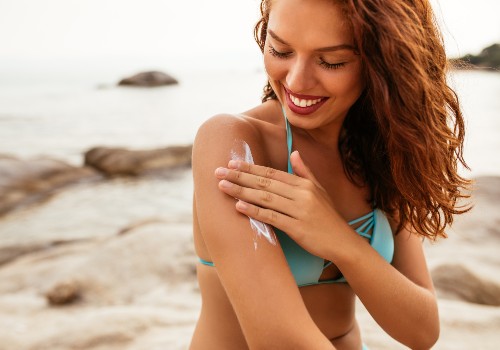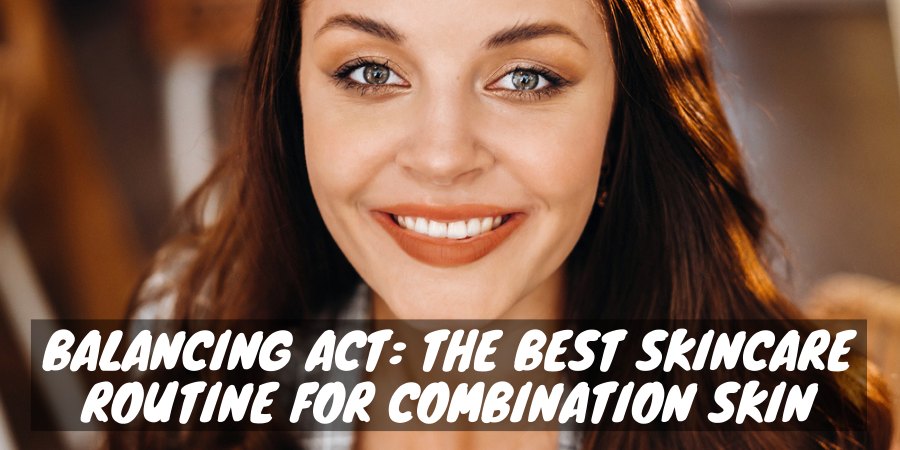Combination skin can be tricky to care for. When the various areas of your face have such different needs, extra attention is required to maintain the perfect balance.
But if you follow these fundamental steps, you’ll have no problem developing a routine that works for you and your skin.
What Is Combination Skin?
Combination skin is exactly what it sounds like: a combination of oily and dry skin types.
Oily skin contains excessive amounts of sebum glands, which produce oil that can clog pores and make you look shiny. Dry skin lacks sebum glands, so it tends to be irritated, flaky and sensitive to the environment.
When these two types of skin coexist on your face, the result is combination skin.
What Does Combination Skin Look and Feel Like?

Most people with combination skin find that their T-zones (forehead, nose and sometimes chin) produce too much oil, while their cheeks and jaw produce too little.
If you have combination skin, you may experience frequent breakouts on your forehead, between your eyebrows and on your chin. Meanwhile, your cheeks and jaw may be red and flaky, and they may feel uncomfortably tight.
The Ultimate Skincare Routine for Combination Skin
Use a Foaming Cleanser to Remove Dirt and Oil
Many cleansers are simply too harsh for combination skin. They remove too much oil, which irritates your dry areas and makes your oily areas produce more sebum to compensate.
That’s why foaming cleansers are ideal for combination skin. They’re effective enough to remove dirt and grime without being so heavy that they strip your skin completely.
Foaming cleansers start out as a gel or cream, but foam up into a lightweight lather when they’re mixed with water. This makes them feel luxurious without skimping on cleansing power.
Some foaming cleansers even contain a gentle exfoliant to remove dead skin as you cleanse, so they’re perfect for the oily zones of your face.
Even Out Your Complexion with an Alcohol-Free Toner
If you have combination skin, you may notice that it feels tight after cleansing, yet some of your pores still feel clogged.
Your skin feels tight because your cleanser has thrown your pH off and removed your moisture barrier. And some spots still feel too oily because cleansers often leave behind a little bit of oil deep in your pores.
That’s where toner comes in. An alcohol-free toner will balance your pH, add some hydration to your skin and knock out the last bits of dirt that remain in your pores.
Toner is great for combination skin because it’s so multipurpose. It soothes your dry patches with extra moisture and deep cleans your oily zones, all while evening out your skin chemistry all over your face.
Find Your Ideal Exfoliation Tactics

Exfoliation is important for all skin types, but if you have combination skin, your run-of-the-mill exfoliant may not be so kind to your skin.
The best way to exfoliate combination skin is to treat your T-zone and the rest of your face separately. By using different formulas on the different parts of your face, you’ll be able to achieve smooth, even results.
On your oiliest spots, use a stronger exfoliant that contains ingredients like salicylic acid or charcoal. These ingredients are excellent at drawing out deep clogs and removing toxins that exacerbate breakouts.
But the dry skin on your cheeks and jaw needs a gentler exfoliant, and it typically can’t handle exfoliation as often as oily skin. Look for an exfoliant that contains hydrating ingredients like glycerin or aloe, and avoid products that contain alcohol or other drying ingredients.
Cover All Your Bases with SPF Moisturizer
SPF moisturizer is the secret weapon in many a skincare arsenal. It performs a double whammy: restoring your skin’s moisture barrier while protecting you from harmful UV rays.
For combination skin, it’s important to pick a moisturizer that’s neither too rich nor too light. Too heavy and you might break out along your T-zone, but too light and your dry areas will lose too much moisture throughout the day.
Look for a moisturizer that’s non-comedogenic, which means that it doesn’t contain pore-clogging ingredients. If possible, pick one that contains plenty of humectants like hyaluronic acid or aloe, which hydrate your skin in addition to protecting it.
As far as SPF, a rating of 30 or higher is ideal, but it’s not always easy to find high SPF moisturizers. Pick one with a minimum SPF of 15 and, if needed, add an extra layer of higher SPF sunscreen before you head out.
Pamper Your Peepers with a Rich Eye Cream

If you have combination skin, chances are that the skin around your eyes tends to be thin, dry and flaky. Often, your eye area is the first to lose elasticity with age, becoming chronically dry and discolored.
A rich eye cream can stop these problems in their tracks and even reverse them. They’re formulated to be gentle on the delicate skin around your eyes while providing ample hydration and stimulating your skin cells.
Look for an eye cream that’s high in antioxidants and in skin-restoring ingredients like retinols. These ingredients will restore firmness and thickness, soothe irritation and brighten up your eyes.
Use an AHA/BHA Serum to Brighten and Hydrate
When your combination skin needs a little extra help to look its best, adding an AHA/BHA serum to your routine can be the perfect solution.
AHA stands for alpha hydroxy acids, while BHA stands for beta hydroxy acids. Both of these types of acids have exfoliating effects, but they’re also fantastic at combating signs of aging like wrinkles and fine lines.
Common AHAs include lactic acid, citric acid and glycolic acid. BHAs found in skincare products include salicylic acid, tropic acid, trethocanic acid and beta hydroxybutanoic acid.
A serum that contains both AHAs and BHAs will smooth out your skin, making it feel and look less patchy. Combination skin responds especially well to AHA/BHA serums, becoming more balanced and taking on a more pleasant overall texture.
Make a Habit of Applying Broad-Spectrum Sunscreen

Even if your moisturizer contains SPF, it’s a good idea to keep a broad-spectrum sunscreen around to reapply throughout the day.
Over-moisturizing isn’t good for combination skin, so re-upping your sun protection with a standalone sunscreen will keep you protected without making you too shiny.
Use a broad-spectrum sunscreen so you’re protected from both UVA and UVB rays. Aim for an SPF of 30 or higher, and make sure your sunscreen is water-resistant if you’ll be swimming or sweating.
Sunscreen loses effectiveness after two hours on the skin, so make sure to reapply it at least that often. Even if you’re not out in the direct sun, UV rays can still cause damage through windows and windshields, so don’t skip it just because you’re staying inside!
Treat Yourself to Clear Pores with a Clay Mask
Everyone’s skin needs some pampering once in a while, but many masks and spa treatments can irritate or unbalance combination skin.
But a mask made of calcium bentonite clay, sometimes called volcanic ash, will work like a dream on your combination skin. It’s powerful enough to draw out even the deepest toxins but gentle enough to please both your oily and dry zones.
You shouldn’t use clay masks too often, but treating yourself every week or two can make your skin smoother, brighter and healthier.

